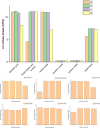Comparative analysis of internal fixation modalities for PER type IV ankle fractures: a finite element study
- PMID: 39180103
- PMCID: PMC11342527
- DOI: 10.1186/s13018-024-05021-2
Comparative analysis of internal fixation modalities for PER type IV ankle fractures: a finite element study
Abstract
Background: There are many options for the surgical treatment of pronation external rotation (PER) type IV ankle fractures, including the use of fibular plates and screws, the aim of this study was to investigate the biomechanical stability and safety of different internal fixation methods for PER type IV ankle fractures via finite element analysis.
Methods: A three-dimensional finite element model of the ankle joint and the whole foot of a healthy 26-years-old adult male was established and validated based on computed tomography images of his lower limb, and a computer-aided design was used to produce a PER type IV ankle fracture and plate and screw model. Four different internal fixation modes were simulated, including a (all ankle fixation-utilizing a fibular plate and screws for comprehensive stabilization of the ankle), b (inferior tibiofibular joint fixation + all ankle fixation), c (inferior tibiofibular joint fixation + unfixed anterior ankle), and d (inferior tibiofibular joint fixation + unfixed anterior and posterior ankles). The results of the four different fixation methods were compared via finite element analysis, and the von Mises stresses. The displacements of the four different fixation methods were analyzed as the output indices.
Results: There were no significant differences between the results of using fibular plates and screws and the displacement of fracture breaks among the four internal fixation modalities. The von Mises stress in the tibiotalar joint, median ankle, posterior ankle, and anterior ankle was minimized in the working condition of d, d, b, and d respectively. The von Mises stress in the fibular plate and screws was minimized in the working condition of a. The von Mises stress in the distal fibula was minimized in the working condition of a. However, the stress was mainly concentrated at the attachment point of the inferior tibiofibular anterior ligament, and in the working condition with inferior tibiofibular joint fixation, the stress was significantly concentrated in the inferior tibiofibular joint screw in all the fibular plates and screws.
Conclusions: The results of this study demonstrate the feasibility of using finite element analysis to compare the biomechanical stability and safety of four configurations of fibular plates and screws for treating PER type IV ankle fractures. All four modalities provided comparable biomechanical stability and safety, showing no significant differences. However, the current limitations of the finite element analysis methodology preclude specific clinical inferences. Further refinement of the methodology in future studies is necessary to enable reliable clinical applications.
Keywords: Ankle fracture; Biomechanics; Finite element analysis; Internal fixation.
© 2024. The Author(s).
Conflict of interest statement
The authors declare no competing interests.
Figures





References
-
- Lauge-Hansen N. Fractures of the ankle II Combined experimental-surgical and experimental-roentgenologic investigations. Arch Surg 1920. 1950;60(5):957–85. - PubMed
Publication types
MeSH terms
LinkOut - more resources
Full Text Sources
Medical

